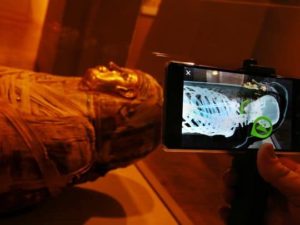Lumin brings augmented reality to Detroit Institute of Art
 Here’s how it works: Each DIA phone has Google Tango built in, which provides an augmented reality platform that doesn't need Wi-Fi or GPS. It then uses another platform, GuidiGO's AR Composer. “These technologies are motion-tracking, depth-sensing and area-learning,” said Tango senior product manager Justin Quimby.
Here’s how it works: Each DIA phone has Google Tango built in, which provides an augmented reality platform that doesn't need Wi-Fi or GPS. It then uses another platform, GuidiGO's AR Composer. “These technologies are motion-tracking, depth-sensing and area-learning,” said Tango senior product manager Justin Quimby.
As the phone continues to move through the environment, the third and final ingredient — area-learning — comes into play. It uses this to recognize a space it has mapped before and then incorporates the augmented reality content into the real world. Sounds complicated, but the whole process works fast and easy.
When viewing the art through augmented reality, you’ll see it in a way that blends overlays, videos, photographs, sounds and touch-activated animations; each provides contextual information. “Without any words, there’s a tremendous amount of explanation,” said Scott.
At the Babylonian Empire, for example, you’ll see a 3D reconstruction of the Ishtar Gate. It was created by closely studying samples of photographs. By rotating your phone, you can also see it at different angles. But to see more details, you have to walk closer — zooming doesn’t work with augmented reality because it’s a real object.
As augmented reality becomes more integrated into our daily lives, new user behaviors will have to be learned.
There’s also the question of what will happen if too much technology is brought into the art world.
See the full story here: http://www.freep.com/story/entertainment/2017/01/21/lumin-detroit-institute-arts-dia-google/96791024/
Pages
- About Philip Lelyveld
- Mark and Addie Lelyveld Biographies
- Presentations and articles
- Tufts Alumni Bio